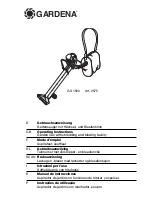
WORK
VACUUMING DRY OBJECTS
PREPARING THE APPLIANCE
To vacuum dry objects, do as follows:
1.
Fig.1
).
2. Select the most suitable accessory for the work to be carried out. Insert the selected
3.
Fig.2
).
ATTENTION:
Do not exceed the maximum mains impedance value allowed for the
electrical connection point (see Technical Data). Please contact your electrical energy
supplier if in doubts concerning mains impedance on the connecting point.
CAUTION:
Do not insert the power cable into the socket of the mains plug with wet
hands.
4.
Fig. 3
).
Before beginning to work, it is necessary to:
1.
Fig.1
).
2.
Fig.2
).
WARNING:
To prevent damaging the power cable, disconnect the plug from the mains
socket by directly pulling the plug and not the cable.
3.
Fig.3
).
N.B:
For dry use, we recommend that you check that the inside of the collection tank
has been drained of all liquids before use.
N.B:
make sure they are positioned correctly.
4.
5. Before using, the appliance must be in order and safe to use with the work equipment,
appliance must not be used.
5. Start work.
N.B:
If while working you note that the vacuum accessory is sticking too much to the
lever on the grip and free the accessory (not valid for A27 WD versions).
ATTENTION:
If when working a reduction in vacuum power is noted or the noise of the appliance becomes
louder:
•
Fig. 3
).
•
Fig.2
).
VACUUMING WET OBJECTS
To vacuum wet objects, do as follows:
1.
Fig.1
).
2.
Fig.2
).
N.B:
make sure they have been removed.
3.
Fig.3
).
N.B. :
For use on wet surfaces, ensure that the inside of the collection tank is free of
any dust before use. For use on wet surfaces the accessory to be used is always
WARNING:
The P11D is not suitable for wet surfaces.
4.
5.
Fig.4
).
6. Select the most suitable accessory for the work to be carried out. Insert the selected
7.
Fig.5
).
ATTENTION:
Do not exceed the maximum mains impedance value allowed for the
electrical connection point (see Technical Data). Please contact your electrical energy
supplier if in doubts concerning mains impedance on the connecting point.
CAUTION:
Do not insert the power cable into the socket of the mains plug with wet
hands.
8.
Fig.6
).
9. Start work.
If when working a reduction in vacuum power is noted or the noise of the appliance becomes
louder:
•
Fig.6
).
•
Fig.5
).
WARNING:
To prevent damaging to the mains socket, disconnect the plug from the
mains socket by directly pulling the plug and not the power cable.
•
Fig.1
).
• Empty the collection tank.
N.B. :
The place intended for this operation must comply with local environmental
regulations.
•
Fig.7
Fig.8
).
•
Fig.3
).
• Repeat the operations in reverse order to start working again.
WARNING:
To prevent damaging to the mains socket, disconnect the plug from the
mains socket by directly pulling the plug and not the power cable.
•
Fig.4
).
•
N.B:
to clean it thoroughly.
• Empty the collection tank.
N.B.:
The place intended for this operation must comply with local environmental
regulations.
• Repeat the operations in reverse order to start working again.
N.B:
remove blockage from the vacuum hose or from the accessories being used.
20
E
N
1
2
1
5
7
6
6
4
5
2
4
3
3
1
1
3
2
2
3
7
8
1
9
2
10
3
4
1
5
6
10
9
8
6
4
5
7
11
















































